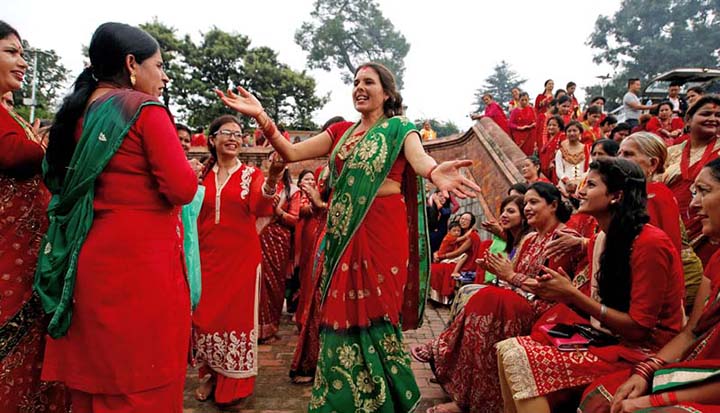
03 August 2019, Kathmandu
Teej is a common name for festivals that are celebrated in Nepal in order to welcome and celebrate the arrival of monsoon after a season of summer heat. The festival is marked by singing, dancing, fasting and prayers by women for the prosperous and welfare of her family. It is such a festival observed for marital happiness, well-being of spouse and children and purification of own body and soul. It is fascinating to see women, in “Red” costumes and attire dancing and singing on the street, going to temple in holy and fasting mood. Teej, also known as Haritalika teej is celebrated by Nepali Hindu women all across the world.

Teej generally falls in late August or early September according to the English calendar traditionally dedicated to the Goddess Parvati, remembering her union with Lord Shiva. It is a three-day-long celebration that combines splendid feasts as well as rigid fasting. The first day of teej is called “dar khaane din”. On this day all the family members especially the women, both married and unmarried gather at one place, in their finest outfits of red which resembles the state of ‘saubhagya’. The second day is the main day of Teej called the fasting day. Some women take it very rigid, they even spent the whole day without having a piece of food and drops of water while some others take liquid and fruit. On this day also, they are seen in red sari and kurtha visiting a nearby Lord Shiva’s temple singing and dancing all the way.

Similarly, on the third day of teej, also called Ganesh Chaturthati, women get up early in the dawn and take bath with red mud found on the roots of the sacred Datiwan bush, along with its leaves and then being ready to worship goddess Shiva and Parvati. The most important part of this puja is a banana and holy basil or Tulsi patta leaf. Only after this puja, women take solid food. Women normally prefer to have Karkalo ko Tarkari made with pure ghee on this day. In this way, teej is being celebrated with huge excitement and joy among women and girls all over the country.

However, the trend of observing this festival today is becoming somehow unacceptable in some extent. Most particularly, these days it is becoming expensive to celebrate Teej as the people seem to be competing in inviting relatives and friends for the dar eating and spending more for other unnecessary ritual practices. Even, nowadays some media have been portraying this festival for promoting culture in the form of commodity vigorously criticized at the same time. Similar to the notion of the modern Teej, it is fostering the religious medium to objectify women. In this contrary, it must be viewed enhancing public discourse in order to identify and discuss and even overcome the social chaos relating to women issues. Thus, teej must be celebrated as a festival to share happiness, courage, dedication, love and so far the religious significance.










